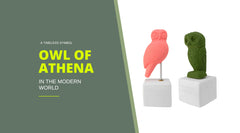3 Famous Greek Statues Depicting Female And Male Beauty
Introduction
Ancient Greek art is full of beautiful statues depicting gods, heroes and everyday people. Greek aesthetics have influenced modern art and its principles are still relevant today.
You can find Greek art everywhere in your daily life, even gifts and accessories based on Greek art or various tasteful Greek busts and statues replicas.
Here are three famous statues that truly stand out from the crowd and express the ideals of Greek beauty:
Venus de Milo - Aphrodite of Milos

Venus de Milo, or Aphrodite of Milos, is a famous Greek statue of a female that dates back to the 2nd century BC. It's one of the most famous sculptures in history since its discovery in 1820 in Milos, Greece.
The goddess Aphrodite was born out of sea foam and represented beauty and love in ancient Greek culture. In this regard, the statue represents an idealized female body—a beautiful face with delicate features, large eyes and a small nose; full lips; gently flowing hair; and a perfectly proportioned physique.
The statue is made from marble (the same material as other ancient Greek statues) but its arms were lost at some point in its history. Because it doesn't have any arms, we can't be sure what gesture or pose it would have held if they were still attached! But there are some suggestions that she may have been hand spinning.
Venus de Milo is prominently displayed at the Louvre museum in Paris.
Nike of Samothrace
The Nike of Samothrace is a sculpture of the Greek goddess Nike. Although this statue was found on Samothrace, it’s not certain where it was created or who designed it. The statue shows Nike as a winged goddess with one arm raised and one lowered in what seems like a welcoming gesture. The statue may have been made to honor an athletic victory or celebrate an important event in the town of Samothrace (like winning a war).

Nike of Samothrace Statuette Replica for the modern interior
The statue was found by the French archaeologist Charles Champoisea in 1863. He recognized that it shows the Goddess of Victory (Nike) since she was always depicted as a winged woman in Greek art history. He sent the various parts he discovered to Louvre in Paris for restoration.
Like Aphrodite of Milos it is also prominently displayed at the Louvre museum. It is one of the most famous female Greek statues.
Hermes of Praxiteles - Hermes and the infant Dionysus

If you've ever seen this statue, you understand why it's considered a masterpiece.
It's called Hermes and the infant Dionysus and it was made by Praxiteles around 330 B.C. It's now on display at the Ancient Olympia museum in Greece.
It depicts the god Hermes (the messenger God) carrying an infant Dionysus. Dionysus is also known as the god of wine, so it is suggested that Hermes was holding grapes on his lost hand, to tease and play with the infant.
The statue was originally created for Hera's temple in Olympia, but it remained there until 1877 when German archaeologists discovered it during an excavation. After being restored, it was returned to its rightful place in the ancient Olympia museum where today anyone can see it!

Find more Greek statues and busts in this blog article about Greek bust replicas.
Greek statues, as well as other forms of Ancient Greek art, reflect the beauty standards of female and male body
When you see a Greek statue, you’re seeing the beauty standards of female and male bodies as Ancient Greeks idealized them. The statues were often of gods and goddesses—and as such, they can tell us about religious beliefs at that time. They also show us what kind of body was considered ideal by society during this time period.
Conclusion
If you have a chance to see any of these statues in person, it’s an experience you won’t forget.
Even if you can’t see them at the moment, we hope these photos have helped to give you a sense of how powerful ancient Greek art remains today and how it celebrates the female and male beauty. Even though many of these statues were destroyed by war or other causes over the years, their impact on the world has been immense.
------
Pictures of Hermes and the infant Dionysus by wikimedia (CC), slightly cropped [1], [2].




















